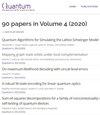从通信复杂性看混合量子密码
IF 5.1
2区 物理与天体物理
Q1 PHYSICS, MULTIDISCIPLINARY
引用次数: 0
摘要
我们在量子计算时间锁(QCT)安全模型中引入了一个密钥分发协议的显式结构,其中假设计算安全加密只有在比可用量子存储器的相干时间长得多的时间后才可能被打破。利用QCT假设,我们从经典策略和量子策略之间单向通信复杂度存在指数差距的隐藏匹配问题出发,构建了一个密钥分发协议HM-QCT。我们建立了HM-QCT对任意id攻击的安全性可以降低到解决底层与经典信息的隐藏匹配问题的难度。另一方面,合法用户可以使用量子通信,这使他们有可能发送相同量子态的多个副本,同时保留信息优势。这导致了在$n$玻色子模式上的永久安全密钥分发方案。这种级别的安全性是纯经典技术无法实现的。值得注意的是,该方案在每个通道使用高达$\mathcal{O}\big( \frac{\sqrt{n}}{\log(n)}\big)$输入光子的情况下保持安全,扩展了功能,并可能比QKD速率高出几个数量级。本文章由计算机程序翻译,如有差异,请以英文原文为准。
Hybrid Quantum Cryptography from Communication Complexity
We introduce an explicit construction for a key distribution protocol in the Quantum Computational Timelock (QCT) security model, where one assumes that computationally secure encryption may only be broken after a time much longer than the coherence time of available quantum memories.
Taking advantage of the QCT assumptions, we build a key distribution protocol called HM-QCT from the Hidden Matching problem for which there exists an exponential gap in one-way communication complexity between classical and quantum strategies.
We establish that the security of HM-QCT against arbitrary i.i.d. attacks can be reduced to the difficulty of solving the underlying Hidden Matching problem with classical information. Legitimate users, on the other hand, can use quantum communication, which gives them the possibility of sending multiple copies of the same quantum state while retaining an information advantage. This leads to an everlasting secure key distribution scheme over $n$ bosonic modes. Such a level of security is unattainable with purely classical techniques. Remarkably, the scheme remains secure with up to $\mathcal{O}\big( \frac{\sqrt{n}}{\log(n)}\big)$ input photons for each channel use, extending the functionalities and potentially outperforming QKD rates by several orders of magnitudes.
Taking advantage of the QCT assumptions, we build a key distribution protocol called HM-QCT from the Hidden Matching problem for which there exists an exponential gap in one-way communication complexity between classical and quantum strategies.
We establish that the security of HM-QCT against arbitrary i.i.d. attacks can be reduced to the difficulty of solving the underlying Hidden Matching problem with classical information. Legitimate users, on the other hand, can use quantum communication, which gives them the possibility of sending multiple copies of the same quantum state while retaining an information advantage. This leads to an everlasting secure key distribution scheme over $n$ bosonic modes. Such a level of security is unattainable with purely classical techniques. Remarkably, the scheme remains secure with up to $\mathcal{O}\big( \frac{\sqrt{n}}{\log(n)}\big)$ input photons for each channel use, extending the functionalities and potentially outperforming QKD rates by several orders of magnitudes.
求助全文
通过发布文献求助,成功后即可免费获取论文全文。
去求助
来源期刊

Quantum
Physics and Astronomy-Physics and Astronomy (miscellaneous)
CiteScore
9.20
自引率
10.90%
发文量
241
审稿时长
16 weeks
期刊介绍:
Quantum is an open-access peer-reviewed journal for quantum science and related fields. Quantum is non-profit and community-run: an effort by researchers and for researchers to make science more open and publishing more transparent and efficient.
 求助内容:
求助内容: 应助结果提醒方式:
应助结果提醒方式:


